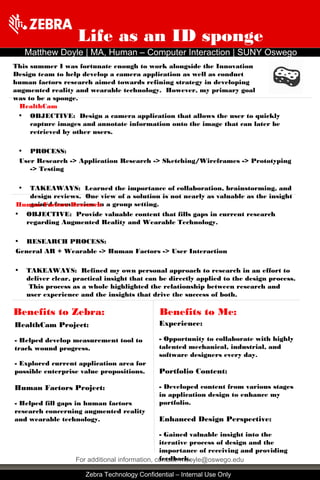Report
Share

Recommended
Recommended
More Related Content
Similar to SummerInternPoster_MatthewDoyle
Similar to SummerInternPoster_MatthewDoyle (20)
User Centered Design Process to Develop a Multi-modal Family Needs Assessment...

User Centered Design Process to Develop a Multi-modal Family Needs Assessment...
Case Study 3 - Portfolio Project Final - Google UX Design Certificate

Case Study 3 - Portfolio Project Final - Google UX Design Certificate
Analytic Design Group Design Research Qualifications

Analytic Design Group Design Research Qualifications
Case Study 2 - Portfolio Project Final - Google UX Design Certificate

Case Study 2 - Portfolio Project Final - Google UX Design Certificate
Simple Ways of Planning, Designing and Testing Usability of a Software Produc...

Simple Ways of Planning, Designing and Testing Usability of a Software Produc...
Interaction design: desiging user interfaces for digital products

Interaction design: desiging user interfaces for digital products
More from Matthew Doyle
More from Matthew Doyle (12)
Robotic Telepresence for the Terraformation of Mars

Robotic Telepresence for the Terraformation of Mars
Poster Presented at the American Astronomical Society 227th Meeting

Poster Presented at the American Astronomical Society 227th Meeting
FutureM Boston Presentation: The Future of Marketing Through Google Glass

FutureM Boston Presentation: The Future of Marketing Through Google Glass
SummerInternPoster_MatthewDoyle
- 1. Zebra Technology Confidential – Internal Use Only Life as an ID sponge For additional information, contact: mdoyle@oswego.edu Benefits to Zebra: Benefits to Me: • HealthCam Project: • - Helped develop measurement tool to track wound progress. • - Explored current application area for possible enterprise value propositions. • Human Factors Project: • - Helped fill gaps in human factors research concerning augmented reality and wearable technology. This summer I was fortunate enough to work alongside the Innovation Design team to help develop a camera application as well as conduct human factors research aimed towards refining strategy in developing augmented reality and wearable technology. However, my primary goal was to be a sponge. Experience: - Opportunity to collaborate with highly talented mechanical, industrial, and software designers every day. Portfolio Content: - Developed content from various stages in application design to enhance my portfolio. Enhanced Design Perspective: - Gained valuable insight into the iterative process of design and the importance of receiving and providing feedback. • HealthCam • OBJECTIVE: Design a camera application that allows the user to quickly capture images and annotate information onto the image that can later be retrieved by other users. • PROCESS: User Research -> Application Research -> Sketching/Wireframes -> Prototyping -> Testing • TAKEAWAYS: Learned the importance of collaboration, brainstorming, and design reviews. One view of a solution is not nearly as valuable as the insight gained from review in a group setting.• Human Factors Research • OBJECTIVE: Provide valuable content that fills gaps in current research regarding Augmented Reality and Wearable Technology. • RESEARCH PROCESS: General AR + Wearable -> Human Factors -> User Interaction • TAKEAWAYS: Refined my own personal approach to research in an effort to deliver clear, practical insight that can be directly applied to the design process. This process as a whole highlighted the relationship between research and user experience and the insights that drive the success of both. Matthew Doyle | MA, Human – Computer Interaction | SUNY Oswego
